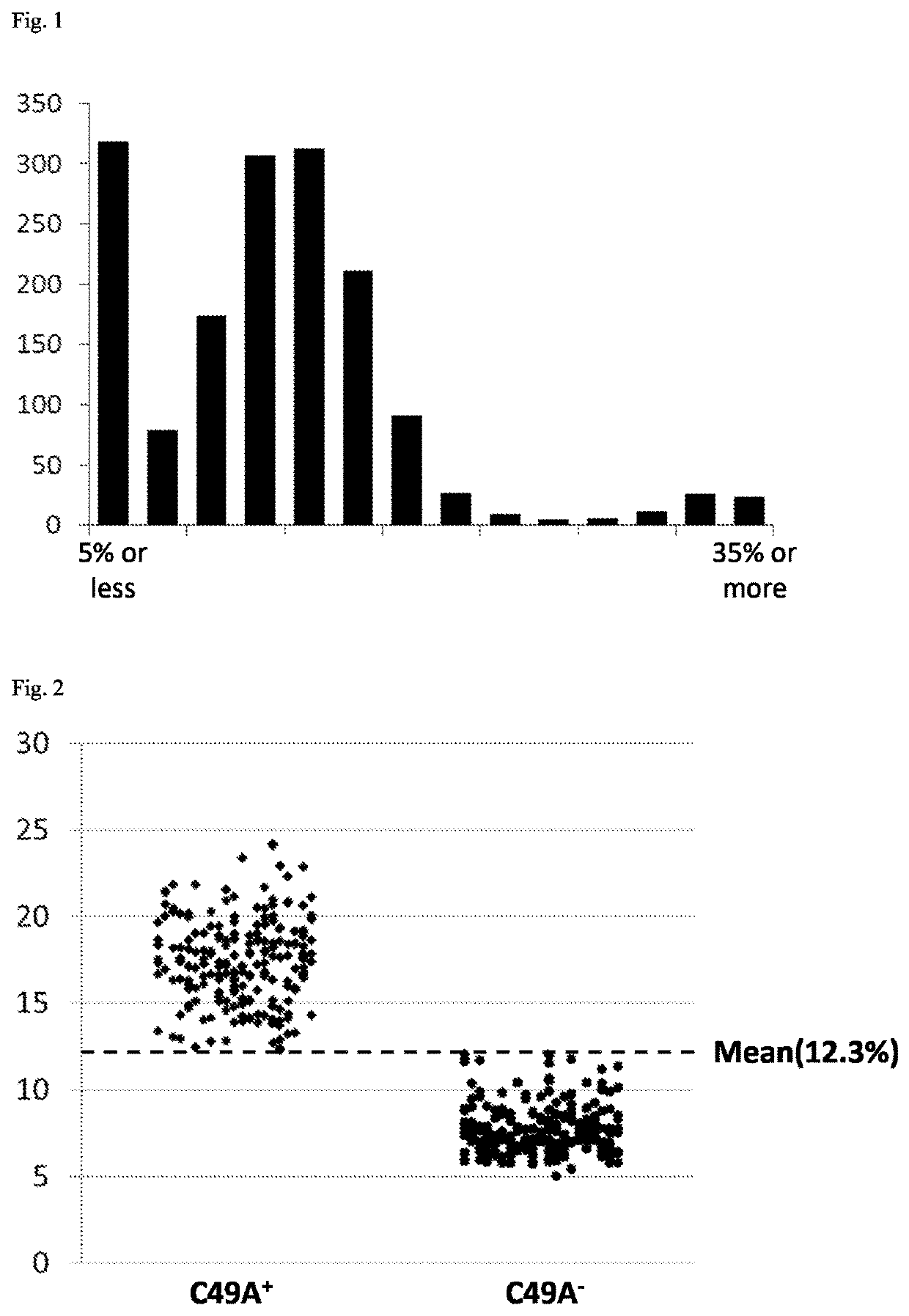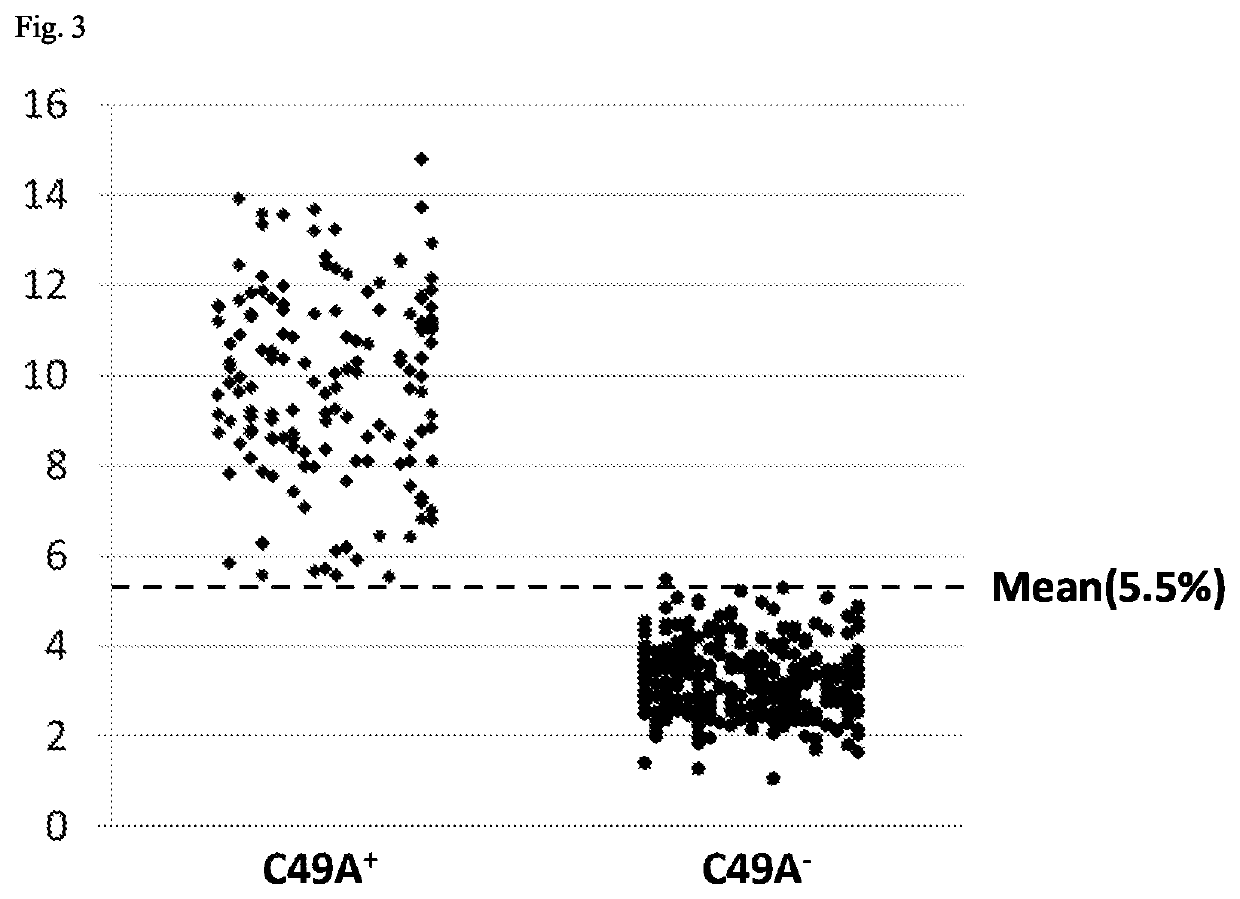Stevia plant having less ability to form flower buds
a technology of stevia and flower buds, applied in the field of stevia plants, can solve the problems of much unknown gene information, and achieve the effects of improving leaf productivity, and low ability to form flower buds
- Summary
- Abstract
- Description
- Claims
- Application Information
AI Technical Summary
Benefits of technology
Problems solved by technology
Method used
Image
Examples
example 1
[Example 1] Verification of Relationship Between RebM Content and Genetic Feature B—(1)
[0239]Individuals derived from commercially available stevia seeds were subjected to selection based on the development and growth condition, the foliar morphology, the contents of total steviol glycoside (TSG), RebA, RebD, and RebM, etc. to obtain two segregating populations, i.e., individual groups I and II. 62 individuals from the individual group I and 109 individuals from the individual group II were used in verification. Each individual group was divided on the basis of RebM content into 3 groups: 0.2% or more, 0.1% or more to less than 0.2%, and 0% or more to less than 0.1%, and examined for the presence or absence of the genetic feature B-1. Specifically, PCR was performed using the primers given below. A restriction enzyme (KpnI) was added to the PCR product, and enzymatic reaction was performed at 37° C. for treatment with the restriction enzyme. After the restriction enzyme treatment, e...
example 2
[Example 2] Verification of Relationship Between RebM Content and Genetic Feature B (2)
[0242]As a result of selecting a plant with high RebM content using the genetic feature B, individuals having a RebM ratio of 2% or more were also able to be selected in segregating populations other than the populations for verification, as shown in the table below, confirming that these genetic markers are capable of serving as practical selection markers. The results of selecting a plant with high RebM content are shown in the table below. In the table, the circle mark represents that the genetic feature B test results were positive.
[0243]The genetic feature B-1 was detected in the same way as in Example 1, and the genetic features B-2 to B-4 were detected as follows.
[0244]For the detection of the genetic feature B-2, PCR was performed using the primers given below. A restriction enzyme (XbaI) was added to the PCR product, and enzymatic reaction was performed at 37° C. for treatment with the re...
example 6
[Example 6] Verification of Relationship Between Ability to Form Flower Buds and Genetic Feature X
[0288]After cutting of two wild type stevia plant lines (W101 and W102) and one variant stevia plant line (M101) which was progeny of individuals genetically modified by a mutagenesis treatment with ethylmethanesulfonic acid (EMS), plants each having 8 true leaves were placed under each condition shown in the table below. Three weeks later, the number of flower buds was counted. The results are shown in the table below (an average value from 3 stocks of each treatment plot, the smallest to largest values within the parentheses).
TABLE 15Line16-hour lighting12-hour lighting8-hour lightingW10108.0 (7-9)16.3 (15-18)W10206.6 (6-8)15.3 (13-18)M1010 0 (0-0)2.0 (0-4)
[0289]As shown in the results, the ability of M101 to form flower buds was markedly low as compared with the wild type line. In order to examine a genetic feature related to this phenotype, the gene sequences of these lines were d...
PUM
| Property | Measurement | Unit |
|---|---|---|
| mass | aaaaa | aaaaa |
| mass | aaaaa | aaaaa |
| mass | aaaaa | aaaaa |
Abstract
Description
Claims
Application Information
 Login to view more
Login to view more - R&D Engineer
- R&D Manager
- IP Professional
- Industry Leading Data Capabilities
- Powerful AI technology
- Patent DNA Extraction
Browse by: Latest US Patents, China's latest patents, Technical Efficacy Thesaurus, Application Domain, Technology Topic.
© 2024 PatSnap. All rights reserved.Legal|Privacy policy|Modern Slavery Act Transparency Statement|Sitemap


